Experimental Study on Mechanical Properties of Concrete at Super-Early Age
Abstract
:1. Introduction
2. Experimental Materials and Process
3. Regression Analysis Method
4. Conclusions
Author Contributions
Funding
Institutional Review Board Statement
Informed Consent Statement
Data Availability Statement
Conflicts of Interest
References
- Mihashi, H.; Leite, J.P.B. State-of-the-art report on control of cracking in early age concrete. J. Adv. Concr. Technol. 2004, 2, 141–154. [Google Scholar] [CrossRef] [Green Version]
- Nehdi, M.; Soliman, A.M. Early-age properties of concrete: Overview of fundamental concepts and state-of-the-art research. Proc. Inst. Civ. Eng.-Constr. Mater. 2011, 164, 57–77. [Google Scholar] [CrossRef]
- Maruyama, I.; Lura, P. Properties of early-age concrete relevant to cracking in massive concrete. Cem. Concr. Res. 2019, 123, 105770. [Google Scholar] [CrossRef]
- Swaddiwudhipong, S.; Lu, H.-R.; Wee, T.-H. Direct tension test and tensile strain capacity of concrete at early age. Cem. Concr. Res. 2003, 33, 2077–2084. [Google Scholar] [CrossRef]
- Yoshitake, I.; Rajabipour, F.; Mimura, Y.; Scanlon, A. A prediction method of tensile Young’s modulus of concrete at early age. Adv. Civ. Eng. 2012, 2012, 391214. [Google Scholar] [CrossRef] [Green Version]
- Hasan, M.M.; Kabir, A. Prediction of compressive strength of concrete from early age test result. In Proceedings of the 4th Annual Paper Meet and 1st Civil Engineering Congress, Dhaka, Bangladesh, 22–24 December 2011; pp. 978–984. [Google Scholar]
- Peng, X.; Zhuang, Z.; Yang, Q. Predictive Modeling of Compressive Strength for Concrete at Super Early Age. Materials 2022, 15, 4914. [Google Scholar] [CrossRef]
- Wolfs, R.J.M.; Bos, F.P.; Salet, T.A.M. Early age mechanical behaviour of 3D printed concrete: Numerical modelling and experimental testing. Cem. Concr. Res. 2018, 106, 103–116. [Google Scholar] [CrossRef]
- Wan, L.; Wendner, R.; Liang, B.; Cusatis, G. Analysis of the behavior of ultra high performance concrete at early age. Cem. Concr. Compos. 2016, 74, 120–135. [Google Scholar] [CrossRef] [Green Version]
- Shen, D.; Wang, X.; Cheng, D.; Zhang, J.; Jiang, G. Effect of internal curing with super absorbent polymers on autogenous shrinkage of concrete at early age. Constr. Build. Mater. 2016, 106, 512–522. [Google Scholar] [CrossRef]
- Shen, D.; Liu, X.; Zeng, X.; Zhao, X.; Jiang, G. Effect of polypropylene plastic fibers length on cracking resistance of high performance concrete at early age. Constr. Build. Mater. 2020, 244, 117874. [Google Scholar] [CrossRef]
- Azenha, M.; Faria, R.; Ferreira, D. Identification of early-age concrete temperatures and strains: Monitoring and numerical simulation. Cem. Concr. Compos. 2009, 31, 369–378. [Google Scholar] [CrossRef]
- Wu, S.; Huang, D.; Lin, F.-B.; Zhao, H.; Wang, P. Estimation of cracking risk of concrete at early age based on thermal stress analysis. J. Therm. Anal. Calorim. 2011, 105, 171–186. [Google Scholar] [CrossRef]
- Zhang, J.; Hou, D.; Gao, Y.; Wei, S. Determination of moisture diffusion coefficient of concrete at early age from interior humidity measurements. Dry. Technol. 2011, 29, 689–696. [Google Scholar] [CrossRef]
- Zhang, J.; Qi, K.; Huang, Y. Calculation of moisture distribution in early-age concrete. J. Eng. Mech. 2009, 135, 871–880. [Google Scholar] [CrossRef]
- Hilaire, A.; Benboudjema, F.; Darquennes, A.; Berthaud, Y.; Nahas, G. Modeling basic creep in concrete at early-age under compressive and tensile loading. Nucl. Eng. Des. 2014, 269, 222–230. [Google Scholar] [CrossRef]
- Zhang, J.; Dongwei, H.; Wei, S. Experimental study on the relationship between shrinkage and interior humidity of concrete at early age. Mag. Concr. Res. 2010, 62, 191–199. [Google Scholar] [CrossRef]
- Altoubat, S.A.; Lange, D.A. Creep, shrinkage, and cracking of restrained concrete at early age. ACI Mater. J. 2001, 98, 323–331. [Google Scholar]
- Di Luzio, G.; Cusatis, G. Solidification–microprestress–microplane (SMM) theory for concrete at early age: Theory, validation and application. Int. J. Solids Struct. 2013, 50, 957–975. [Google Scholar] [CrossRef] [Green Version]
- Soliman, A.M.; Nehdi, M.L. Effect of drying conditions on autogenous shrinkage in ultra-high performance concrete at early-age. Mater. Struct. 2011, 44, 879–899. [Google Scholar] [CrossRef]
- Wong, A.; Childs, P.A.; Berndt, R.; Macken, T.; Peng, G.; Gowripalan, N. Simultaneous measurement of shrinkage and temperature of reactive powder concrete at early-age using fibre Bragg grating sensors. Cem. Concr. Compos. 2007, 29, 490–497. [Google Scholar] [CrossRef]
- Zhao, Z.; Wang, K.; Lange, D.A.; Zhou, H.; Wang, W.; Zhu, D. Creep and thermal cracking of ultra-high volume fly ash mass concrete at early age. Cem. Concr. Compos. 2019, 99, 191–202. [Google Scholar] [CrossRef]
- Cortas, R.; Rozière, E.; Staquet, S.; Hamami, A.; Loukili, A.; Delplancke-Ogletree, M.-P. Effect of the water saturation of aggregates on the shrinkage induced cracking risk of concrete at early age. Cem. Concr. Compos. 2014, 50, 1–9. [Google Scholar] [CrossRef]
- Liu, G.T.; Gao, H.; Chen, F.Q. Microstudy on creep of concrete at early age under biaxial compression. Cem. Concr. Res. 2002, 32, 1865–1870. [Google Scholar] [CrossRef]
- Farah, M.; Grondin, F.; Alam, S.; Loukili, A. Experimental approach to investigate creep-damage bilateral effects in concrete at early age. Cem. Concr. Compos. 2019, 96, 128–137. [Google Scholar] [CrossRef]
- Østergaard, L.; Lange, D.A.; Altoubat, S.A.; Stang, H. Tensile basic creep of early-age concrete under constant load. Cem. Concr. Res. 2001, 31, 1895–1899. [Google Scholar] [CrossRef]
- Ansell, A.; Silfwerbrand, J. The vibration resistance of young and early-age concrete. Struct. Concr. 2003, 4, 125–134. [Google Scholar] [CrossRef]
- Dunham, M.R.; Rush, A.S.; Hanson, J.H. Effects of induced vibrations on early age concrete. J. Perform. Constr. Facil. 2007, 21, 179–184. [Google Scholar] [CrossRef]
- Wojtowicz, A.; Michalek, J.; Ubysz, A. Range of dynamic impact of geotechnical works on reinforced concrete structures. In Proceedings of the XXII International Scientific Conference “Construction the Formation of Living Environment” (FORM-2019), Tashkent, Uzbekistan, 18–21 April 2019; Volkov, A., Pustovgar, A., Sultanov, T., Adamtsevich, A., Eds.; EDP Sciences: Les Ulis, France, 2019; pp. 1–8. [Google Scholar]
- Wojtowicz, A.; Ubysz, A.; Michałek, J. How vibrations affect steel-to-concrete adherence. In Proceedings of the VI International Scientific Conference “Integration, Partnership and Innovation in Construction Science and Education” (IPICSE-2018), Moscow, Russia, 14–16 November 2018; Volkov, A., Pustovgar, A., Adamtsevich, A., Eds.; EDP Sciences: Les Ulis, France, 2018; Volume 251, pp. 1–8. [Google Scholar]
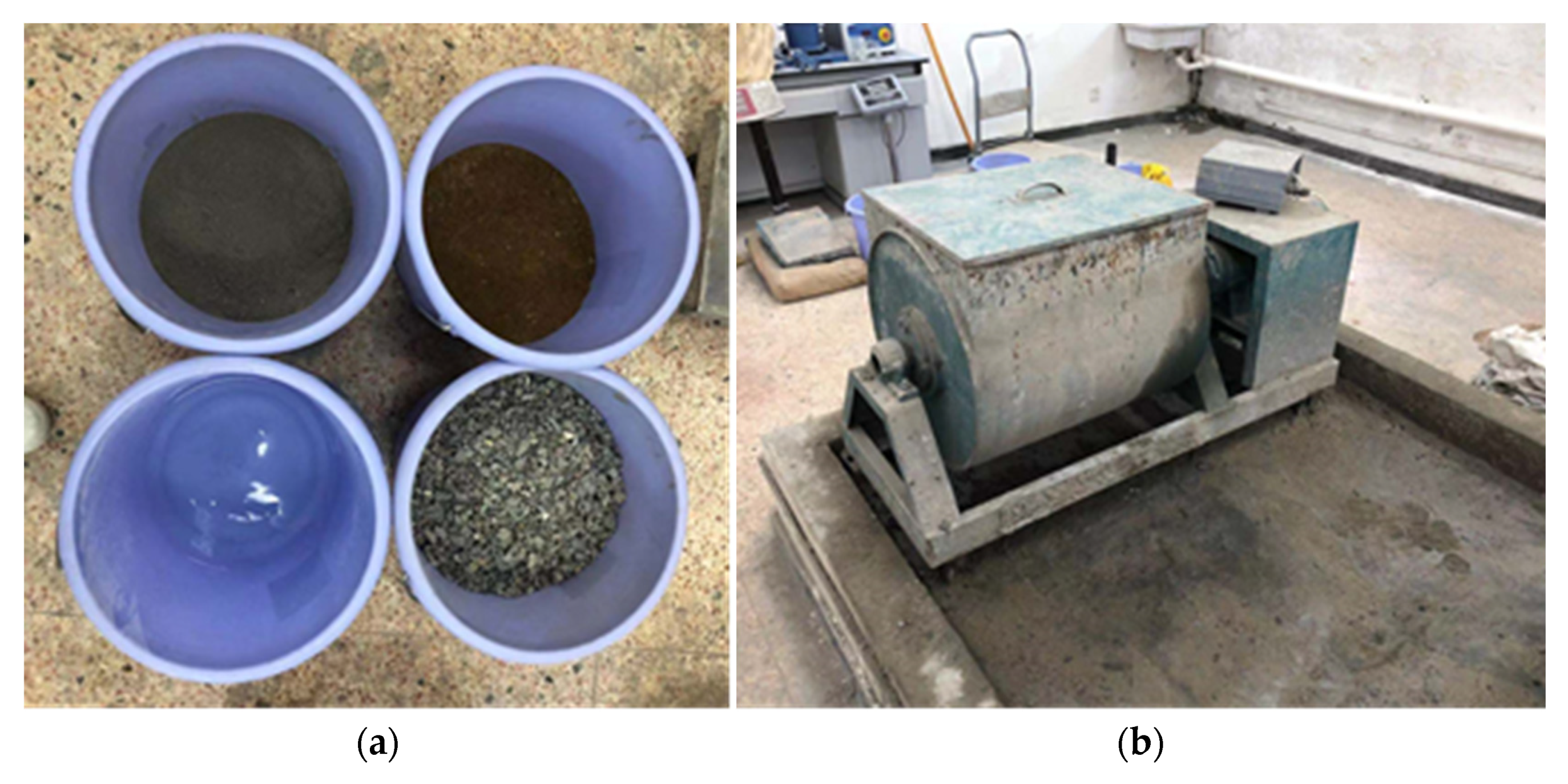
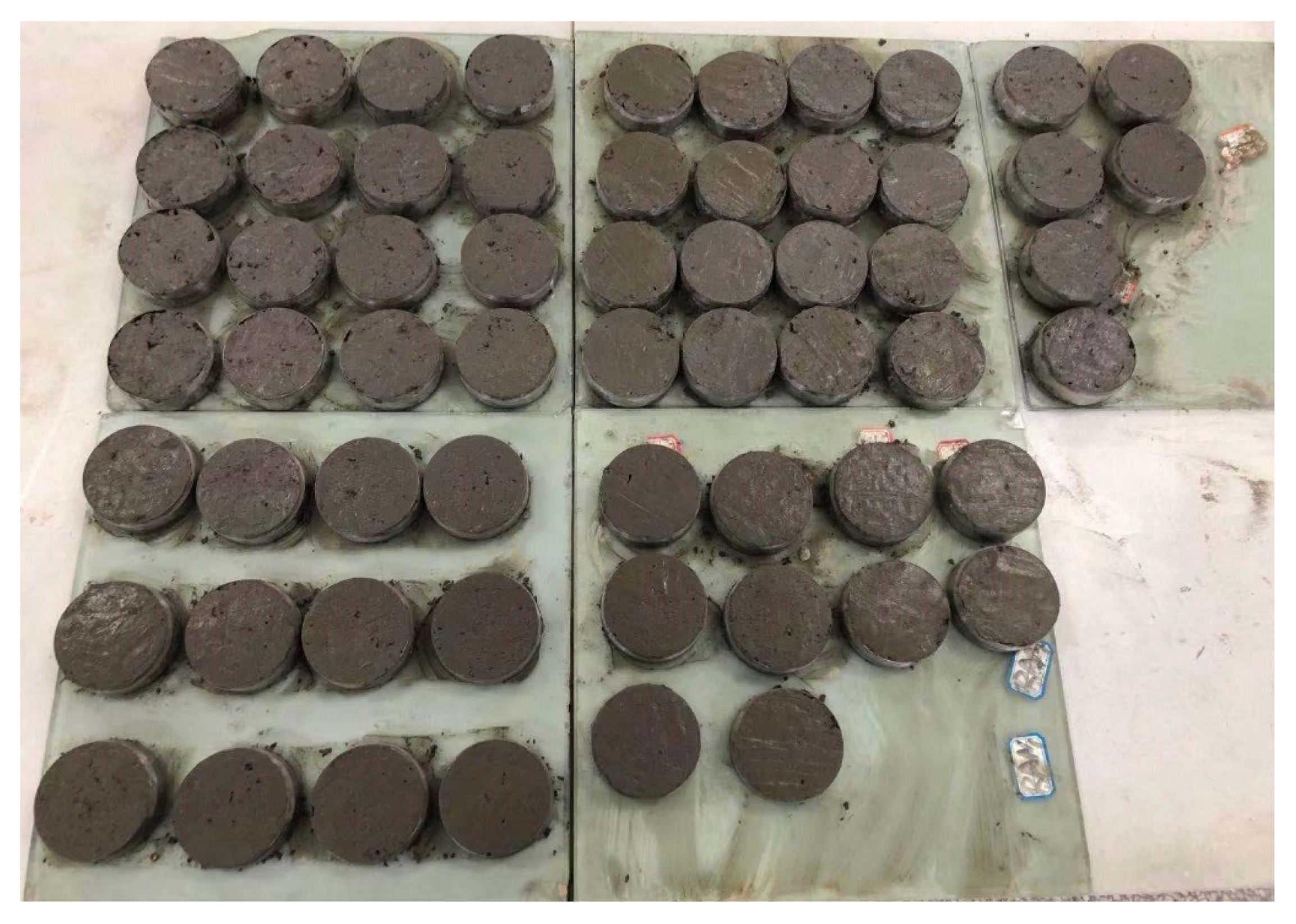
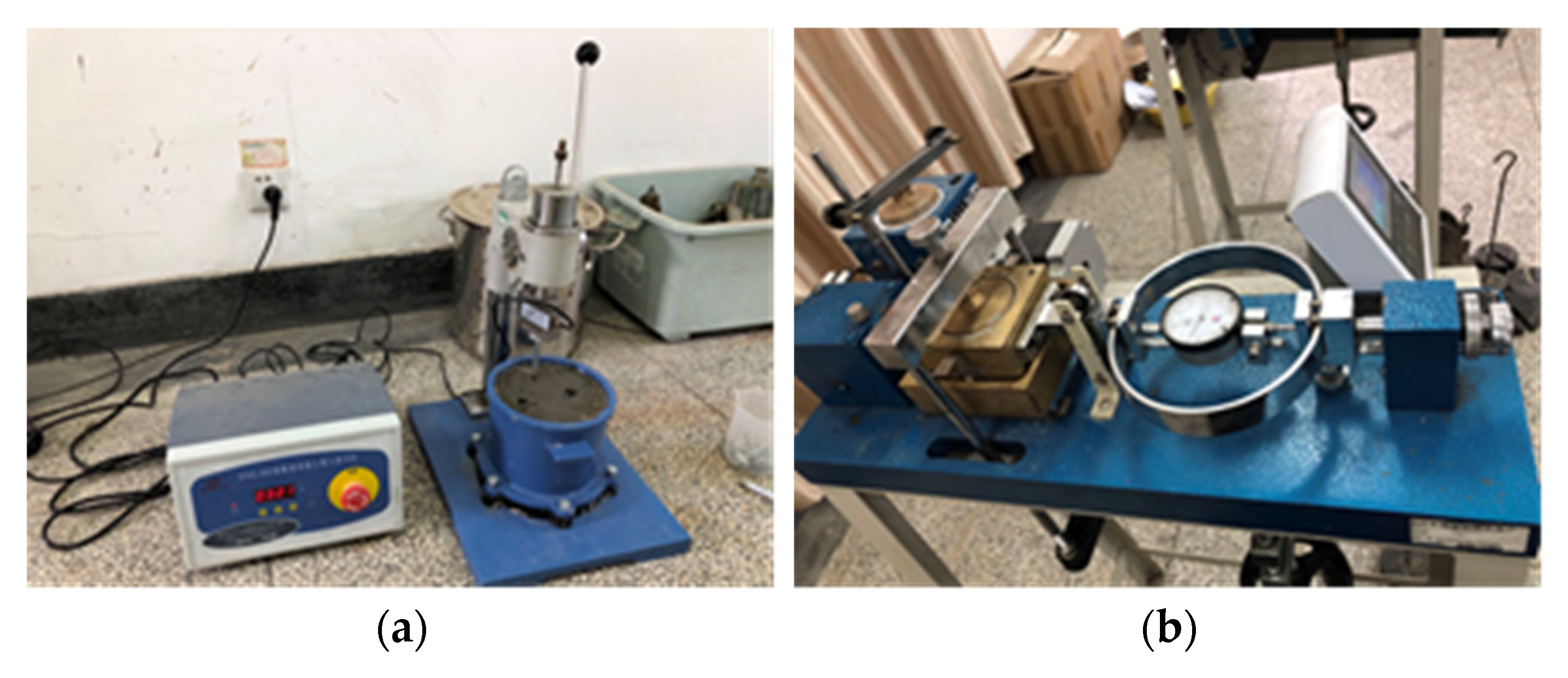
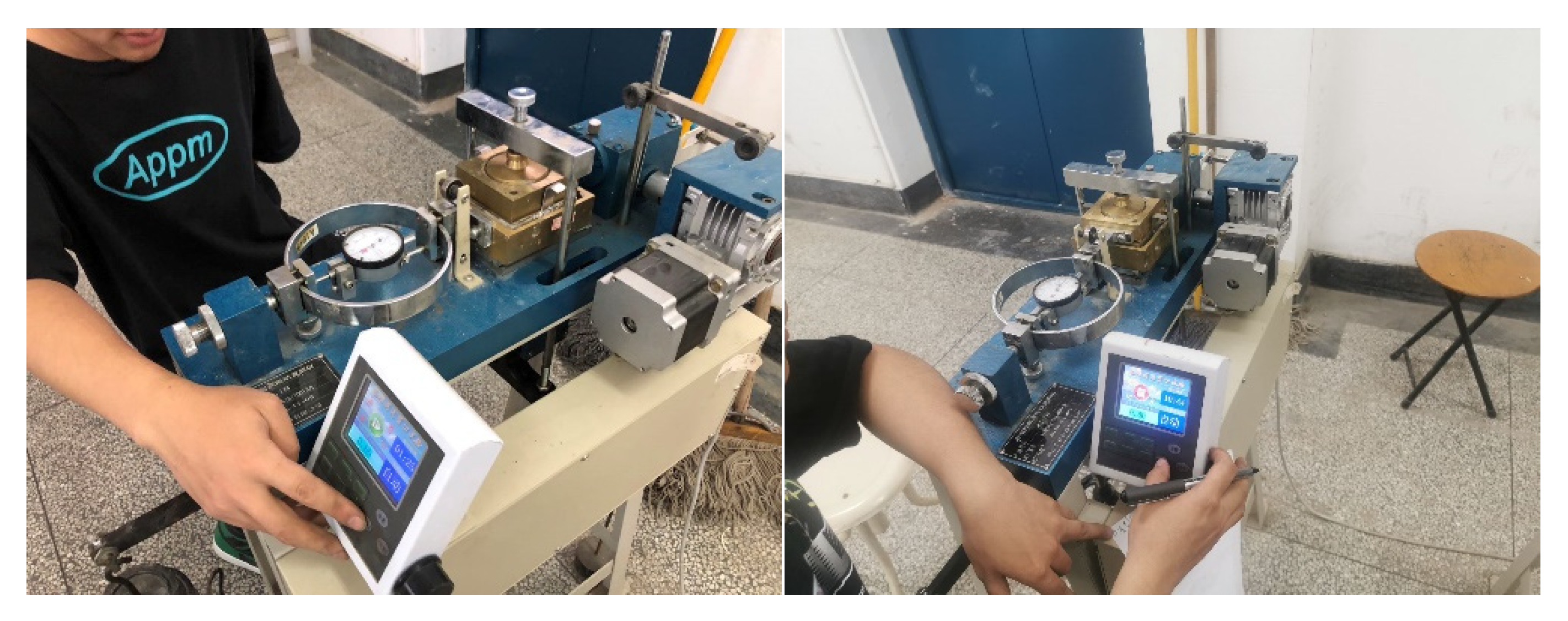

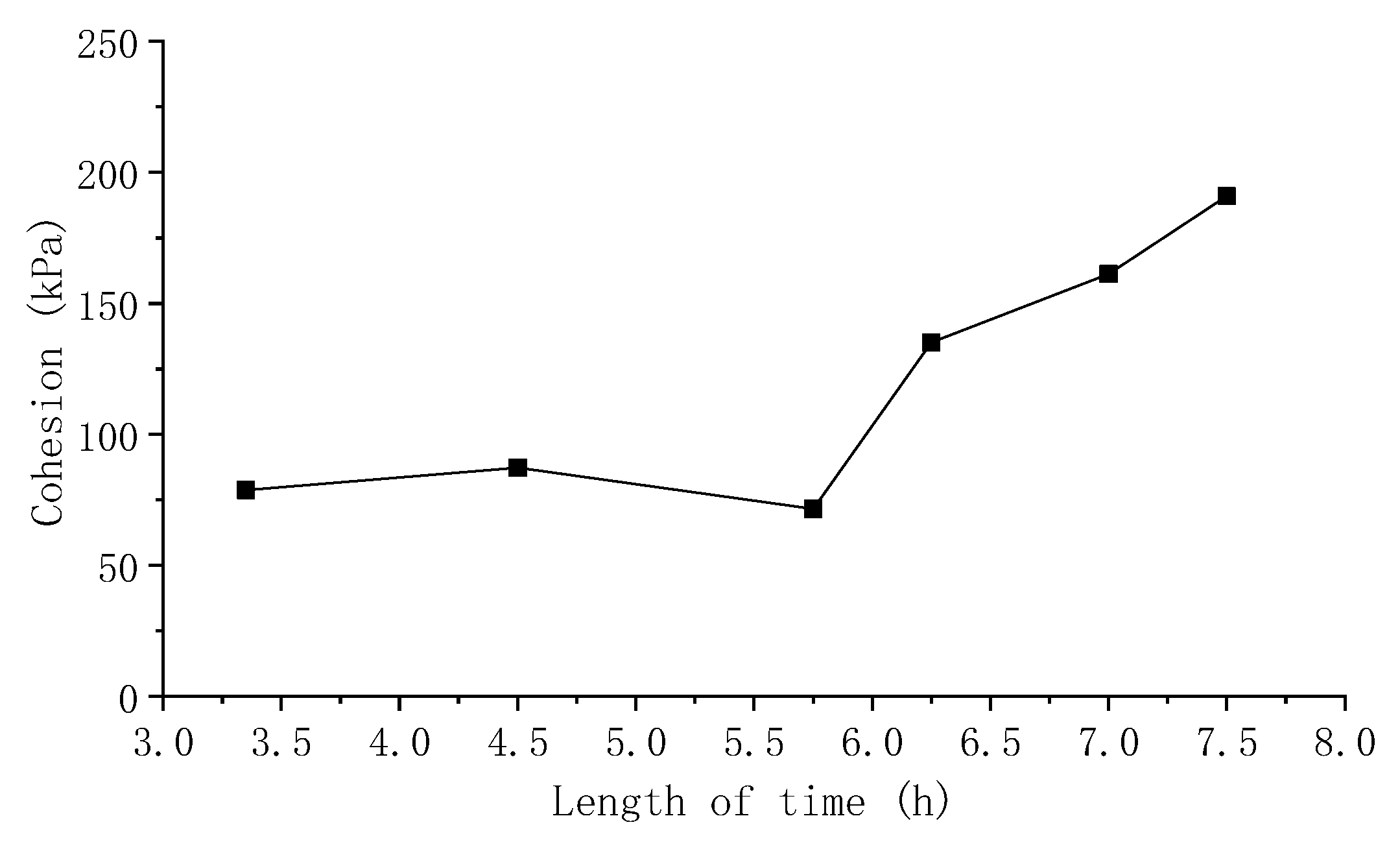
| Cement: Water: Sand: Coarse Aggregate = 1:0.43:1.22:2.27 | |||
|---|---|---|---|
| Cement | Water | Fine Aggregate | Coarse Aggregate |
| 488.37 kg/m3 | 210 kg/m3 | 595.57 kg/m3 | 1106.06 kg/m3 |
| Time | 12:11 a.m. | 14:00 p.m. | 15:05 p.m. | 16:20 p.m. |
|---|---|---|---|---|
| The penetration resistance | 3.87 MPa | 6.24 MPa | 21.8 MPa | 31.5 MPa |
| Time | ||||
|---|---|---|---|---|
| = 100 kPa | = 200 kPa | = 300 kPa | = 400 kPa | |
| 12:11 a.m. | 203.6 | 372.9 | 481.1 | 578.3 |
| 12:41 a.m. | 192.8 | 374.7 | 482.8 | 756.7 |
| 13:20 p.m. | 236.0 | 454.9 | 562.2 | 681.9 |
| 14:00 p.m. | 151.4 | 414.4 | 351.4 | 924.3 |
| 14:35 p.m. | 281.1 | 390.1 | 618.0 | 909.9 |
| 15:05 p.m. | 324.3 | 320.7 | 500.0 | 891.9 |
| 15:50 p.m. | 331.5 | 341.4 | 672.1 | 720.7 |
| 16:20 p.m. | 264.9 | 434.2 | 454.9 | 677.5 |
| Time | 12.11 a.m. | 12:41 a.m. | 13:20 p.m. | 14:00 p.m. | 14:35 p.m. | 15:05 p.m. | 15:50 p.m. | 16:20 p.m. |
|---|---|---|---|---|---|---|---|---|
| 1.2323 (50.94°) | 1.7998 (60.94°) | 1.4450 (55.32°) | 2.2557 (66.09°) | 2.1143 (64.69°) | 1.8821 (62.02°) | 1.4983 (56.28°) | 1.2585 (51.53°) | |
(, kPa) | 100.9 | 1.8 | 122.5 | −103.55 | 21.2 | 38.7 | 141.85 | 143.25 |
| Time | 12.11 a.m. | 12:41 a.m. | 13:20 p.m. | 14:00 p.m. | 14:35 p.m. | 15:05 p.m. | 15:50 p.m. | 16:20 p.m. |
|---|---|---|---|---|---|---|---|---|
() | 1.2490 (51.32°) | 1.8738 (61.91°) | 1.4863 (56.07°) | 2.5820 (68.82°) | 2.096 (64.49°) | 1.892 (62.14°) | 1.7030 (59.58°) | 1.2165 (50.58°) |
(, kPa) | 78.7 | 3.603 | 87.3667 | −105.7337 | 71.5 | 135.1 | 161.2 | 190.9 |
| Length of Time | 3.35 h | 4.5 h | 5.75 h | 6.25 h | 7 h | 7.5 h |
|---|---|---|---|---|---|---|
| Cohesion (kPa) | 78.7 | 87.3667 | 71.5 | 135.1 | 161.2 | 190.9 |
Publisher’s Note: MDPI stays neutral with regard to jurisdictional claims in published maps and institutional affiliations. |
© 2022 by the authors. Licensee MDPI, Basel, Switzerland. This article is an open access article distributed under the terms and conditions of the Creative Commons Attribution (CC BY) license (https://creativecommons.org/licenses/by/4.0/).
Share and Cite
Yang, Q.; Sun, Y.; Peng, X. Experimental Study on Mechanical Properties of Concrete at Super-Early Age. Materials 2022, 15, 7582. https://doi.org/10.3390/ma15217582
Yang Q, Sun Y, Peng X. Experimental Study on Mechanical Properties of Concrete at Super-Early Age. Materials. 2022; 15(21):7582. https://doi.org/10.3390/ma15217582
Chicago/Turabian StyleYang, Qiuwei, Yun Sun, and Xi Peng. 2022. "Experimental Study on Mechanical Properties of Concrete at Super-Early Age" Materials 15, no. 21: 7582. https://doi.org/10.3390/ma15217582
APA StyleYang, Q., Sun, Y., & Peng, X. (2022). Experimental Study on Mechanical Properties of Concrete at Super-Early Age. Materials, 15(21), 7582. https://doi.org/10.3390/ma15217582







